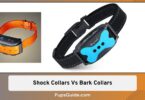Some folks are on the fence about shock collars, but when used right, they can be solid tools for training your four-legged buddy. You just have to sure that collar fits your pup just right.
Let’s dig into why that fit matters, give you a step-by-step to get the sweet spot between effective training and keeping your furball comfy, and mistakes to avoid.
Let’s start find outing “How Tight Should a Shock Collar Be?”.
Getting the Fit Right – 5 Steps
You’ve probably heard about the two-finger rule, saying you should fit two fingers between the collar and your dog’s neck. It’s a cool start, but it’s not a one-size-fits-all deal. Dogs come in all shapes and sizes, so what’s snug for a big guy might be too loose for a smaller one.
Now, the two-finger rule dictates how tight should a shock collar be, but you still need to be careful. You’re aiming for snug without the ouch factor. Tight enough for the training to work, but not so tight your pup’s uncomfortable.
1. High and Tight
Pop that collar high on your dog’s neck, just below the ears. This spot gets it close to the vocal cords, making training vibes hit home. Don’t go too low; you don’t want it messing with your pup’s groove.
2. Two Fingers In
Alright, back to those two fingers. After you’ve strapped the collar on, slip two fingers between it and your dog’s skin. It should be comfy, not a finger-wrestling match.
3. Check for Snug
While keeping those two fingers in place, give the collar a gentle tug. It shouldn’t slide around like it’s on a water slide but shouldn’t chokehold your pup either. Watch for any signs of distress.
4. Watch the Behavior
Collar on? Now watch your dog. If they’re scratching, pawing at it, something’s off. Adjust the fit until your pup’s cool with it.
5. Stay Active
Dogs move a lot. Make sure the collar stays snug during the action when your dog is super active. Check and tweak as needed.
Getting the Right Fit Before You Buy A Training Collar
Finding the right fit is one thing, why not take things right from the start? Here’s how to do it.
1. Measure Up
Before you slap a shock collar on your pup, measure their neck right by using a soft tape and measure the base of the neck just above the shoulders – get the digits. This magic number guides you when you’re picking a collar.
2. Pick the Right Size
Collars come in sizes, like shoes. Get one that matches your dog’s neck size. Too small equals ouch; too big means training will miss the mark.
3. Check for Adjustability
A good shock collar should grow with your pup. Look for buckles or clasps to tweak the fit. Snug, not strangling.
4. Know Your Dog’s Body
Different breeds, different shapes. Bulldogs and Greyhounds don’t wear the same-sized clothes, and neither should their collars. Think about your dog’s build for a fit that’s just right.
5. Factor in Age and Growth
Puppies grow like weeds. Get an adjustable collar to roll with the changes. Keep an eye on the fit as they grow, especially during the puppy months.
6. Hair Matters
Fur’s not just for looks. Thick-coated pups might need longer prongs for good contact. Shorter hair should have shorter prongs. Adjust as the seasons change.
7. Comfort Zone Check
Dogs have preferences. Some don’t mind collars; others act like it’s a fashion disaster. Watch your pup’s vibe when trying on the collar. If it’s a thumbs-down, figure out why.
8. Avoid Blockages
Dogs explore with their mouths and noses. Make sure the collar doesn’t mess with their breathing, eating, or drinking. No one wants a collar-caused breathing issue.
10. Material Matters
Not all dogs dig the same materials. Some pups get itchy or allergic. Check the collar material and switch if your dog’s not feeling it.
Mistakes to Avoid
Avoid these mistakes at all costs for the well-being of your dog.
1. Weight Changes
Dogs pack on pounds or shed them. A too-tight or too-loose collar won’t do the job.
2. No Ignoring Signs
Dogs talk with actions. Don’t brush off your buddy’s actions. Fix the fit before it becomes a big deal.
3. Seasonal Fit
Like winter coats for us, dogs can change size with the seasons. Keep tabs on your pup’s weight, especially during weather shifts.
4. Hair Game Strong
Fur changes with the seasons too. A snug fit in winter might be too tight come summer. Keep an eye on the fluff factor and adjust as needed.
5. Watch for Irritation
A collar on the skin can mean irritation. Check your pup’s neck for redness or sores. If you spot trouble, give the collar a break and call in the vet if needed.
6. Gentle Collar Introduction
Don’t slap a collar on and dive into training. Let your dog ease into it. Start with just wearing the collar, then move to training mode. Positive vibes only.
7. Check for Wear and Tear
Collars wear out like your favorite sneakers. Regularly give it a once-over. Swap it out for a fresh one when your collar gets frayed bits or wonky electronics.
How Tight Should a Shock Collar Be? Conclusion
Shock collars can be a dog trainer’s sidekick when used smartly. The right fit makes all the difference.
Follow my step-by-step guide above, consider your pup’s size, style, and comfort, and you’re set for a training adventure that’s effective and cozy for your fur buddy.
The two-finger rule is cool but customize it for your unique pup. Get that fit right, and you and your pet will be on the road to training success.








Leave a Comment